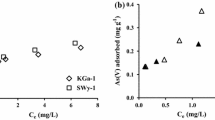Abstract
In the present study, the influence of kaolinite and goethite on microbial degradation of methyl parathion was investigated. We observed that the biodegradation process was improved by kaolinite and depressed by goethite. Calorimetric data further showed that the metabolic activities of degrading cells (Pseudomonas putida) were enhanced by the presence of kaolinite and depressed by the presence of goethite. A semipermeable membrane experiment was performed and results supported the above observations: the promotive effect of kaolinite and the inhibition of goethite for microbial degradation was not found when the bacteria was enclosed by semipermeable membrane and had no direct contact with these minerals, suggesting the important function of the contact of cellular surfaces with mineral particles. The relative larger particles of kaolinite were loosely attached to the bacteria. This attachment made the cells easy to use the sorbed substrate and then stimulated biodegradation. For goethite, small particles were tightly bound to bacterial cells and limited the acquisition of substrate and nutrients, thereby inhibiting biodegradation. These results indicated that interfacial interaction between bacterial cells and minerals significantly affected the biodegradation of pesticides.






Similar content being viewed by others
References
Atkinson RJ, Posner AM, Quirk JP (1967) Adsorption of potential-determining ions at the ferric oxide–aqueous electrolyte interface. J Phys Chem 71:550–558
Bouchez M, Blanchet D, Vandecasteele JP (1995) Substrate availability in phenanthrene biodegradation: transfer mechanism and influence on metabolism. Appl Microbiol Biotechnol 43:952–960
Chaerun SK, Tazaki K, Asada R, Kogure K (2005) Interaction between clay minerals and hydrocarbon-utilizing indigenous microorganisms in high concentrations of heavy oil: implications for bioremediation. Clay Miner 40:105–114
Chang YT, Lee JF, Chao HP (2007) Variability of communities and physiological characteristics between free-living bacteria and attached bacteria during the PAH biodegradation in a soil/water system. Eur J Soil Biol 43:283–296
Courvoisier E, Dukan S (2009) Improvement of Escherichia coli growth by kaolinite. Appl Clay Sci 44:67–70
Dehner CA, Barton L, Maurice PA, Dubois JL (2011) Size-dependent bioavailability of hematite (alpha-Fe2O3) nanoparticles to a common aerobic bacterium. Environ Sci Technol 45:977–983
Feng YC, Park JH, Voice TC, Boyd SA (2000) Bioavailability of soil-sorbed biphenyl to bacteria. Environ Sci Technol 34:1977–1984
Harms H, Zehnder AJ (1994) Influence of substrate diffusion on degradation of dibenzofuran and 3-chlorodibenzofuran by attached and suspended bacteria. Appl Environ Microbiol 60:2736–2745
Hattori T (1973) Microbial life in the soil. Marcel Dekker, New York
Jeffrey WH, Paul JH (1986) Activity of an attached and free-living Vibrio sp. as measured by thymidine incorporation, p-iodonitrotetrazolium reduction, and ATP/DNA ratios. Appl Environ Microbiol 51:150–156
Jiang D, Huang Q, Cai P, Rong X, Chen W (2007) Adsorption of Pseudomonas putida on clay minerals and iron oxide. Colloids Surf B 54:217–221
Johnsen AR, Wick LY, Harms H (2005) Principles of microbial PAH-degradation in soil. Environ Pollut 133:71–84
Kieft TL, Caldwell DE (1984) Chemostat and in situ colonization kinetics of Thermothrix thiopara on calcite and pyrite surfaces. Geomicrobiol J 3:217–229
Laor Y, Strom PF, Farmer WJ (1996) The effect of sorption on phenanthrene bioavailability. J Biotechnol 51:227–234
Lavie S, Stotzky G (1986) Adhesion of the clay minerals montmorillonite, kaolinite, and attapulgite reduces respiration of Histoplasma capsulatum. Appl Environ Microbiol 51:65–73
Leglize P, Alain S, Jacques B, Corinne L (2008) Adsorption of phenanthrene on activated carbon increases mineralization rate by specific bacteria. J Hazard Mater 151:339–347
Park JH, Zhao X, Voice TC (2002) Development of a kinetic basis for bioavailability of sorbed naphthalene in soil slurries. Water Res 36:1620–1628
Park JH, Feng YC, Ji PS, Voice TC, Boyd SA (2003) Assessment of bioavailability of soil-sorbed atrazine. Appl Environ Microbiol 69:3288–3298
Rong X, Huang Q, Chen W (2007) Microcalorimetric investigation on the metabolic activity of Bacillus thuringiensis as influenced by kaolinite, montmorillonite and goethite. Appl Clay Sci 38:97–103
Schnürer Y, Persson P, Nilsson M, Nordgren A, Giesler R (2006) Effects of surface sorption on microbial degradation of glyphosate. Environ Sci Technol 40:4145–4150
Singh N, Megharaj M, Gates WP, Churchman GJ, Anderson J, Kookana RS, Naidu R, Chen Z, Slade PG, Sethunathan N (2003) Bioavailability of an organophosphorus pesticide, fenamiphos, sorbed on an organo clay. J Agric Food Chem 51:2653–2658
Smith KEC, Thullner M, Wick LY, Harms H (2009) Sorption to humic acids enhances polycyclic aromatic hydrocarbon biodegradation. Environ Sci Technol 43:7205–7211
Van Schie PM, Fletcher M (1999) Adhesion of biodegradative anaerobic bacteria to solid surfaces. Appl Environ Microbiol 65:5082–5088
Weissenfels WD, Klewer HJ, Langhoff J (1992) Adsorption of polycyclic aromatic hydrocarbons (PAHs) by soil particles: influence on biodegradability and biotoxicity. Appl Microbiol Biotechnol 36:689–696
Xia XH, Yu H, Yang ZF, Huang GH (2006) Biodegradation of polycyclic aromatic hydrocarbons in the natural waters of the Yellow River: effects of high sediment content on biodegradation. Chemosphere 65:457–466
Yang Y, Hunter W, Tao S, Gan J (2009) Microbial availability of different forms of phenanthrene in soils. Environ Sci Technol 43:1852–1857
Yang Y, Shu L, Wang XL, Xing BS, Tao S (2010) Effects of composition and domain arrangement of biopolymer components of soil organic matter on the bioavailability of phenanthrene. Environ Sci Technol 44:3339–3344
Yang Y, Shu L, Wang XL, Xing BS, Tao S (2012) Mechanisms regulating bioavailability of phenanthrene sorbed on a peat soil-origin humic substance. Environ Toxicol Chem 31:1431–1437
Zhang LX, Liu Y, Cia LH, Hu YJ, Yin J, Hu PZ (2006) Inhibitory study of some novel Schiff base derivatives on Staphylococcus aureus by microcalorimetry. Thermochim Acta 440:51–56
Zierath DL, Hassett JJ, Banwart WL, Wood SG, Means JC (1980) Sorption of benzidine by sediments and soils. Soil Sci 129:277–281
Acknowledgments
This research was financially supported by the National Natural Science Foundation of China (Grant No. 41101240) and the Fundamental Research Funds for the Central Universities (Program No. 2011QC043).
Author information
Authors and Affiliations
Corresponding author
Rights and permissions
About this article
Cite this article
Zhao, G., Huang, Q., Rong, X. et al. Interfacial interaction between methyl parathion-degrading bacteria and minerals is important in biodegradation. Biodegradation 25, 1–9 (2014). https://doi.org/10.1007/s10532-013-9635-4
Received:
Accepted:
Published:
Issue Date:
DOI: https://doi.org/10.1007/s10532-013-9635-4



